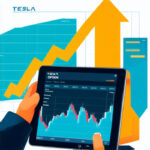Tesla MarketWatch: How Tesla is Shaping the Future of Transportation

Introduction to Tesla MarketWatch
When it comes to revolutionizing transportation, Tesla is a name that stands out. Tesla MarketWatch is essential for anyone interested in the future of transportation. Monitoring Tesla’s market performance gives valuable insights into industry trends, technological advancements, and financial metrics. Tesla’s mission to accelerate the world’s transition to sustainable energy makes it a pivotal player in the automotive and energy sectors. This blog post delves into how Tesla is shaping the future of transportation and why keeping an eye on Tesla MarketWatch is crucial for investors, consumers, and industry watchers.
Overview of Tesla’s Mission and Vision
Tesla’s mission is simple yet profound: to accelerate the world’s transition to sustainable energy. Founded in 2003 by Elon Musk and a team of engineers, Tesla aims to prove that electric vehicles (EVs) can be better, quicker, and more fun to drive than gasoline cars. Their vision extends beyond automobiles to include renewable energy solutions and energy storage. Tesla’s holistic approach to sustainability is what sets it apart from other automakers. By focusing on innovation, Tesla is not just a car manufacturer but a technology and energy company committed to creating a sustainable future.
Importance of Monitoring Tesla’s Market Performance
Keeping an eye on Tesla MarketWatch is crucial for several reasons. First, Tesla’s stock performance often serves as a barometer for the broader EV market and renewable energy sectors. Investors and analysts closely monitor Tesla’s quarterly earnings reports, stock fluctuations, and key financial metrics. Secondly, Tesla’s market performance impacts consumer sentiment and adoption rates. Positive market trends can boost consumer confidence, leading to increased sales and market share. Lastly, Tesla’s innovations and advancements set industry standards, making it essential for competitors and industry stakeholders to stay informed.
Tesla’s Impact on the Automotive Industry
Innovations in Electric Vehicles (EVs)
Tesla has been at the forefront of EV innovation since its inception. Their vehicles are known for their exceptional performance, long-range capabilities, and cutting-edge technology. The Tesla Model S, Model 3, Model X, and Model Y have set new standards in the automotive industry. Innovations such as over-the-air software updates, advanced battery technology, and proprietary Supercharger networks have made Tesla a leader in the EV market. By continuously pushing the boundaries of what’s possible, Tesla is driving the entire automotive industry towards a more sustainable future.
Market Share and Competitor Analysis
Tesla has managed to carve out a significant share of the global EV market. As of the latest data, Tesla holds a substantial portion of the market, outperforming traditional automakers and newer EV startups. Companies like General Motors, Ford, and Volkswagen are investing heavily in their EV programs to catch up. However, Tesla’s first-mover advantage and continuous innovation keep it ahead of the curve. Analyzing Tesla’s market share in comparison to its competitors provides valuable insights into the industry’s competitive landscape and future trends.
Consumer Adoption of Tesla Vehicles
Consumer adoption of Tesla vehicles has been remarkable. Tesla’s brand is synonymous with innovation, quality, and sustainability, attracting a loyal customer base. The company’s direct-to-consumer sales model, coupled with an extensive Supercharger network, enhances the overall ownership experience. Furthermore, Tesla’s focus on user-friendly interfaces and software-driven features appeals to tech-savvy consumers. The growing trend of eco-consciousness among consumers also plays a significant role in Tesla’s increasing adoption rates. Understanding consumer behavior and preferences is essential for predicting future market trends and Tesla’s potential growth.
Technological Advancements Driving Tesla’s Growth
Autopilot and Full Self-Driving Capabilities
One of Tesla’s most talked-about innovations is its Autopilot and Full Self-Driving (FSD) capabilities. These advanced driver-assistance systems use a combination of cameras, sensors, and artificial intelligence to provide semi-autonomous and, eventually, fully autonomous driving experiences. While full autonomy is still a work in progress, Tesla’s continuous software updates improve the system’s capabilities over time. The potential for fully autonomous vehicles could revolutionize transportation, making it safer and more efficient. Tesla’s commitment to developing these technologies highlights its role as a pioneer in the future of transportation.
Battery Technology and Energy Efficiency
Battery technology is at the heart of Tesla’s success. Tesla’s proprietary battery packs offer long-range capabilities, quick charging times, and impressive energy efficiency. The company’s Gigafactories are designed to scale battery production, reducing costs and improving performance. Innovations such as the 4680 battery cell promise to further enhance energy density and reduce manufacturing costs. Tesla’s advancements in battery technology extend beyond vehicles to energy storage solutions like the Powerwall and Powerpack, contributing to a more sustainable energy ecosystem. These innovations are critical for Tesla’s growth and the broader adoption of electric vehicles.
Role of Artificial Intelligence and Machine Learning
Artificial intelligence (AI) and machine learning (ML) play a pivotal role in Tesla’s technological advancements. From Autopilot to vehicle manufacturing, AI and ML algorithms optimize performance, improve safety, and enhance user experiences. Tesla’s neural network processes vast amounts of data from its fleet to continually improve its self-driving capabilities. In manufacturing, AI-driven robots and predictive analytics streamline production processes, reducing costs and increasing efficiency. Tesla’s expertise in AI and ML not only sets it apart in the automotive industry but also positions it as a leader in the broader tech landscape.
Financial Performance and Market Trends
Quarterly Earnings Reports
Tesla’s quarterly earnings reports are highly anticipated events that provide insights into the company’s financial health and operational performance. These reports detail revenue, profit margins, vehicle delivery numbers, and other key metrics. Positive earnings reports often lead to stock price surges, while missed targets can result in declines. Investors and analysts scrutinize these reports to gauge Tesla’s growth trajectory and market position. Understanding the nuances of Tesla’s earnings reports is essential for making informed investment decisions and predicting future market trends.
Stock Performance and Investor Sentiment
Tesla’s stock performance has been nothing short of remarkable. From its initial public offering (IPO) to its current status as one of the most valuable automakers, Tesla’s stock has experienced significant volatility and growth. Investor sentiment is influenced by various factors, including earnings reports, market trends, and broader economic conditions. Positive developments in technology and market expansion often boost investor confidence, while regulatory challenges and production issues can lead to stock declines. Keeping an eye on Tesla’s stock performance and investor sentiment is crucial for understanding market dynamics and investment opportunities.
Key Financial Metrics to Watch
Several key financial metrics are essential for monitoring Tesla’s market performance. Revenue growth, profit margins, and earnings per share (EPS) are fundamental indicators of financial health. Vehicle delivery numbers and production capacity provide insights into operational efficiency and market demand. Cash flow and capital expenditures are critical for understanding Tesla’s investment in future growth and innovation. Monitoring these metrics helps investors and analysts assess Tesla’s performance, identify potential risks, and make informed decisions. Staying informed about these financial metrics is crucial for anyone interested in Tesla MarketWatch.
Expansion Beyond Automobiles
Tesla Energy and Solar Solutions
Tesla’s vision extends beyond automobiles to include renewable energy solutions. Tesla Energy offers products like the Powerwall, Powerpack, and Solar Roof, designed to create a sustainable energy ecosystem. The Powerwall and Powerpack are energy storage solutions that enable homes and businesses to store surplus solar energy for later use. The Solar Roof integrates solar panels seamlessly into a roof, providing an aesthetically pleasing renewable energy solution. By diversifying into energy products, Tesla aims to reduce global reliance on fossil fuels and create a sustainable future. These innovations highlight Tesla’s commitment to sustainability beyond the automotive industry.
The Role of Tesla in the Global Energy Market
Tesla’s impact on the global energy market is significant. The company’s energy products and solutions contribute to the broader adoption of renewable energy sources. Tesla’s Gigafactories are not only producing batteries for electric vehicles but also for energy storage solutions. By enabling the storage of renewable energy, Tesla addresses one of the biggest challenges in the energy sector: intermittency. Tesla’s involvement in large-scale energy projects, such as grid storage solutions and virtual power plants, further solidifies its role in the global energy market. Tesla’s innovations are paving the way for a more sustainable and resilient energy infrastructure.
Challenges and Criticisms
Regulatory and Legal Hurdles
Tesla faces several regulatory and legal challenges. The evolving regulatory landscape for autonomous driving technology is one such hurdle. Different regions have varying regulations, making it challenging to achieve global rollout of Tesla’s Full Self-Driving capabilities. Additionally, Tesla has faced legal issues related to labor practices, safety standards, and environmental regulations. Navigating these challenges requires a robust legal and compliance strategy. While these hurdles pose risks, they also highlight the need for regulatory frameworks that can keep pace with rapid technological advancements. Understanding these challenges is crucial for assessing Tesla’s long-term prospects and potential risks.
Quality Control and Production Issues
Quality control and production issues have been recurring challenges for Tesla. Rapid scaling of production has sometimes compromised quality, leading to recalls and customer complaints. Production bottlenecks and supply chain disruptions have also impacted delivery timelines and financial performance. Tesla’s Gigafactories are designed to address some of these challenges by streamlining production and increasing capacity. However, maintaining high-quality standards while scaling production remains a critical focus for the company. Addressing these issues is essential for sustaining consumer trust and ensuring long-term success in a competitive market.
Public Perception and Media Coverage
Public perception and media coverage significantly impact Tesla’s market performance and brand reputation. Positive media coverage of Tesla’s innovations and financial performance can boost consumer confidence and stock prices. Conversely, negative coverage related to accidents, legal issues, or production challenges can harm Tesla’s reputation and market value. Elon Musk’s public statements and social media activity also influence public perception and investor sentiment. Managing public perception and media relations is crucial for Tesla’s ongoing success. Understanding the dynamics of media coverage helps stakeholders stay informed and make informed decisions about Tesla’s future prospects.
Future Prospects for Tesla
Upcoming Models and Innovations
Tesla’s future prospects are bolstered by a pipeline of upcoming models and innovations. The highly anticipated Cybertruck, Roadster, and Semi promise to expand Tesla’s market reach and attract new customer segments. The Cybertruck’s unique design and advanced features have already generated significant interest. The Roadster aims to redefine performance, while the Semi targets the commercial trucking industry with promises of lower operational costs and zero emissions. Tesla’s continuous focus on innovation ensures that it remains a leader in the automotive industry. These upcoming models and innovations highlight Tesla’s commitment to pushing the boundaries of what’s possible.
Expansion into New Markets
Tesla’s expansion into new markets is a key driver of its future growth. The company’s entry into regions like China and Europe has already shown promising results. Tesla’s Gigafactories in Shanghai and Berlin are strategically positioned to meet growing demand in these markets. Additionally, Tesla’s focus on developing markets presents new opportunities for growth. By localizing production and tailoring products to regional preferences, Tesla aims to increase its global footprint. Expansion into new markets not only boosts sales but also strengthens Tesla’s position as a global leader in sustainable transportation and energy solutions.
Long-term Vision for Sustainable Transportation
Tesla’s long-term vision for sustainable transportation extends beyond electric vehicles. The company’s focus on autonomous driving, renewable energy, and energy storage solutions aims to create an integrated ecosystem for sustainable living. Tesla envisions a future where autonomous electric vehicles powered by renewable energy sources dominate the transportation landscape. This vision includes reducing traffic congestion, lowering emissions, and improving safety. By continuously innovating and expanding its product offerings, Tesla is committed to driving the world’s transition to sustainable energy. This long-term vision underscores Tesla’s role in shaping the future of transportation and creating a more sustainable world.
Conclusion: Tesla’s Role in Shaping the Future
Recap of Key Points
In summary, Tesla MarketWatch is essential for understanding the future of transportation and sustainable energy. Tesla’s mission and vision drive its innovations in electric vehicles, battery technology, and autonomous driving. Monitoring Tesla’s market performance provides insights into financial health, investor sentiment, and industry trends. Tesla’s expansion beyond automobiles into renewable energy solutions highlights its commitment to sustainability. Despite challenges and criticisms, Tesla continues to push the boundaries of what’s possible. By staying informed about Tesla’s advancements and market trends, stakeholders can better understand the company’s impact on the automotive and energy sectors.
The Broader Impact on the Transportation Industry
Tesla’s influence extends beyond its own products and services. The company’s innovations and market success have spurred traditional automakers and new startups to accelerate their own EV programs. Tesla’s advancements in battery technology and autonomous driving set industry standards, driving the entire sector towards a more sustainable future. The company’s focus on renewable energy and energy storage solutions contributes to a broader transition to sustainable energy sources. By redefining what’s possible in transportation and energy, Tesla is shaping the future and paving the way for a more sustainable and efficient world.

Laura Henderson is an enthusiast and has been writing on cutting-edge topics for years.







